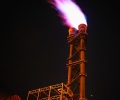EIA lowers 2021 spot gas price forecast; expects production growth, flat consumption

The US Energy Information Administration has trimmed its forecast for Henry Hub spot natural gas prices in 2022, as gas consumption estimates were tempered by lower power-sector use of the fuel, and production growth was expected from the second quarter onward.
The agency, in its January Short-Term Energy Outlook released Jan. 11, lowered its forecast for Q1 Henry Hub natural gas spot prices by 76 cents to $3.82/MMBtu. The Q2 forecast also fell 4 cents from the previous month’s estimates to $3.78/MMBtu.
“Although we expect natural prices to decline in 2022 and 2023 compared with 2021, prices in the forecast stay relatively high compared with recent years,” the outlook said. It attributed that dynamic in part to reductions in coal-fired generating capacity and constraints in the coal market that make coal generation less sensitive to natural gas prices.
In addition, EIA said gas prices could still see volatility related to weather-related demand, and uncertainty tied to rising gas exports.
The agency estimated Henry Hub natural gas prices would average $3.79/MMBtu for full-year 2022, down 19 cents from the prior month’s forecast, with prices declining further to average $3.63/MMBtu in 2023.
Gas consumption trends
Overall, the agency expected US gas consumption to be relatively flat, averaging 82.77 Bcf/d in 2022, down slightly from 82.96 Bcf/d in 2021, before creeping up to 82.84 Bcf/d in 2023.
It raised consumption estimates by 1.58 Bcf/d to 99.05 Bcf/d for Q1, but lowered its Q2 estimate by 340 MMcf/d to 70.91 Bcf/d.
Consumption of gas by the power sector will average 6% lower in 2022 than in 2021, as renewable sources experience rapid growth, the agency forecast. A further 2% decline in power-sector gas consumption was expected in 2023.
“Renewable energy will continue to contribute an increasing share of US electricity generation over the next two years, but the growth of solar will significantly outpace growth in other renewables,” said EIA Administrator Steve Nalley said in a statement accompanying the report’s release.
The agency expected the share of the generation mix from renewables to increase to 23% in 2022 and 24% in 2023. Consumption of solar power was forecast to increase 27.3% in 2022 and 25.2% in 2023.
Overall, annual US residential retail sales of electricity are forecast to decline 2.2% in 2022, reflecting a cooler forecast for the summer, offsetting a cooler fourth-quarter forecast, EIA said.
The share of gas-fired generation was seen declining to 35% in 2022, from 37% in 2021. But Industrial sector consumption of gas was seen rising 3% to 23.2 Bcf/d in 2022, with residential and commercial consumption combined also up 4% that year.
But continuing the pull on US gas, EIA forecast that net gas exports would reach a record high of 13.4 Bcf/d in 2022 and 14.3 Bcf/d in 2023, driven by both LNG exports and pipeline exports to Mexico. Expansions and optimizations at US LNG facilities were expected to increase total US export capacity in 2022, allowing the US to to have the world’s largest export capacity.
EIA forecast that LNG exports will average 11.5 Bcf/d in 2022, up from 9.8 Bcf/d in 2021.
Supply
The outlook showed upswing in production. EIA raised by 890 MMcf/d to 104.21 Bcf/d its natural gas marketed production estimate for the US in Q1, and increased the Q2 production forecast by 330 MMcf/d to 103.79 Bcf/d.
Total marketed production was seen averaging 104.32 Bcf/d in 2022, and rising to 106.09 Bcf/d in 2023, compared with 101.35 Bcf/d in 2021.
“Recent increases in oil and domestic natural gas prices contribute to an overall increase in drilling activity in 2022 that will lead to production growth from 2Q22 onward,” EIA said, with growth in dry gas production led by the Haynesville and the Permian basins.
US gas inventories are forecast to total 1.82 Tcf at the end of March, 8% more than the five-year average. However, EIA said demand growth in the industrial sector and exports will dampen the pace during the April-October injection season, leaving inventories at 3.67 Tcf at the end of October, within 1% of the five-year average.
Source: Platts

 Hellenic Shipping News Worldwide Hellenic Shipping News Worldwide, Online Daily Newspaper on Hellenic and International Shipping
Hellenic Shipping News Worldwide Hellenic Shipping News Worldwide, Online Daily Newspaper on Hellenic and International Shipping























 PG-Software
PG-Software